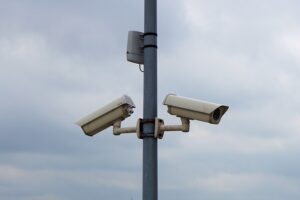| Contact us if you are a camera manufacturer / supplier or a property manager / construction company and you have questions about remote power for pan/tilt/zoom cameras |

What is an Pan-Tilt-Zoom (PTZ) Camera?
A PTZ camera is a sophisticated surveillance device that offers a wide range of motion and zoom capabilities, making it ideal for monitoring large areas or tracking specific subjects. Unlike fixed cameras that have a limited field of view, PTZ cameras provide flexibility and dynamic control.
Key Features of PTZ Cameras:
- Pan: This refers to the camera’s ability to rotate horizontally, allowing it to scan a wide area from left to right.
- Tilt: This feature enables the camera to move vertically, tilting up and down to cover different angles.
- Zoom: PTZ cameras have powerful optical zoom lenses that allow users to magnify distant objects or scenes for closer inspection.
Applications of PTZ Cameras:
PTZ cameras are used in various settings, including:
- Security and Surveillance: Monitoring public spaces, businesses, and private properties.
- Traffic Management: Observing traffic flow and identifying congestion or accidents.
- Wildlife Monitoring: Studying animal behavior and tracking wildlife populations in remote locations.
- Sports and Events: Capturing dynamic footage of sporting events and concerts.
The Rise of Off-Grid Solar Power for PTZ Cameras
Traditional PTZ cameras rely on grid power for operation. However, there’s a growing trend towards using off-grid solar power systems to provide a reliable and sustainable energy source for these cameras, especially in remote locations where grid access is limited or unavailable.
Benefits of Off-Grid Solar Power for PTZ Cameras:
- Cost Savings: Off-grid solar power eliminates or reduces ongoing electricity bills, providing long-term cost savings. Moreover, if your camera is in a remote area, it can cost over $50,000 per mile to connect it to an electric grid so it is much more economically viable to install an off-grid solar powered system.
- Environmental Friendliness: Solar energy is a clean and renewable resource, reducing carbon emissions and environmental impact.
- Reliability: Off-grid solar systems with battery backup ensure continuous operation even during power outages.
- Remote Accessibility: Solar power enables the deployment of PTZ cameras in remote areas where grid connectivity is challenging.
Components of an Off-Grid Solar Power System for PTZ Cameras:
- Solar Panels (Modules): These capture sunlight and convert it into electricity.
- Solar Charge Controller: This regulates the flow of electricity from the solar panels to the batteries, preventing overcharging and damage.
- Solar Batteries: These store the electricity generated by the solar panels for use when sunlight is unavailable, such as at night or during cloudy weather.
- Backup Power Source (Optional): A generator or fuel cell can provide additional power during extended periods of low sunlight.
Challenges in Choosing the Right Components:
- Solar Charge Controller: Selecting the appropriate type (PWM or MPPT) and size of the charge controller is crucial for optimal system performance and battery longevity.
- Solar Module: Factors like panel efficiency, power output, and durability should be considered based on the camera’s power consumption and location’s climate.
- Solar Battery: Battery capacity, type (lead-acid, lithium-ion), and cycle life are important considerations to ensure sufficient backup power.
Challenges in Installing and Maintaining Off-Grid Systems:
- Site Assessment: Evaluating solar irradiance, shading, and environmental factors is essential for optimal system placement and performance.
- Installation Expertise: Proper installation of solar panels, wiring, and components requires technical knowledge and experience.
- Remote Maintenance: Accessing remote sites for maintenance or repairs can be challenging and costly.
- Environmental Factors: Extreme weather conditions, wildlife, and vandalism can pose risks to the off-grid system.
Conclusion
Off-grid solar power is transforming the way PTZ cameras are deployed, particularly in remote and challenging environments. While there are challenges in selecting the right components and maintaining these systems, the benefits of cost savings, reliability, and environmental sustainability make it a compelling solution for powering PTZ cameras in the modern age. Careful planning, expert installation, and regular maintenance are crucial for maximizing the performance and lifespan of off-grid solar-powered PTZ camera systems.
